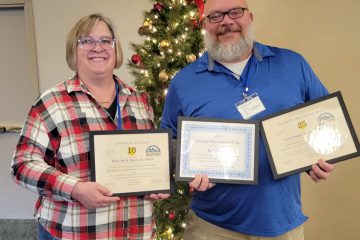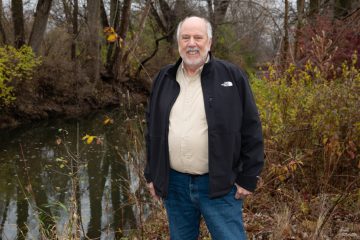The national STAR program featured Illinois STAR – started at the Champaign County Soil & Water Conservation District – in their January newsletter. Subscribe to the newsletter here.
This month we highlight the Illinois STAR Affiliate – where STAR first started in 2017 when two Central Illinois farmers wondered how they could encourage neighbors to find new ways to prevent nutrient losses from fields. Steve Stierwalt and Joe Rothermel were successful using reduced-tillage and cover crops to improve soil health and reduce soil and nutrient losses, and they thought there must be a simple, straightforward way to help make such conservation farming the norm.
“We were just kicking around ideas for a roadmap for conservation practices,” Rothermel said. “Say a farmer wanted to try conservation practices: What would we tell them? Make a list of all the practices that would work best in this area – a recipe for success. It recognizes farmers for their practices – but there is also an educational part of it. My goal was to provide information to farmers who wanted to try this.”
“We had no vision of building something that would even go across Illinois,” Stierwalt said. “We wanted to focus on Champaign County. But we found a lot of interest. My personal ‘Why’ was discomfort at seeing that we were not getting done what was needed. Joe came up with the STAR acronym. Having a name that tells people what we’re hoping to do is important.”
Stierwalt and Rothermel then teamed up with the Champaign County Soil and Water Conservation District (CCSWCD) to formally establish STAR across Illinois – and this eventually inspired a national expansion into what STAR is today. Stierwalt and Rothermel continue to serve on the Illinois and national STAR boards.
Illinois STAR continues its expansion across the state and has benefited from the expertise and guidance of representatives from key state organizations including The Nature Conservancy, American Farmland Trust, Illinois Soybean Association, Illinois Corn Growers Association, Association of Illinois Soil and Water Conservation Districts, and many other conservation focused partners. Recognized conservation advocates, researchers and experts throughout the Illinois academic, consulting, and farming communities have been instrumental in the success of the initiative through participation on the Illinois STAR Steering Committee. Along with continued CCSWCD support, Illinois STAR is supported by the Illinois Department of Agriculture, Bureau of Land and Water Resources (IDOA), as part of the soil health goals set forth by the Illinois General Assembly Public Act 103-0490. IDOA and STAR share a common vision to enhance agricultural conservation practices and raise awareness regarding nutrient and soil loss mitigation. Together, they work on education and training opportunities to promote conservation and the Illinois STAR Initiative. The Illinois STAR Initiative is efficiently administered through most county Soil and Water Conservation Districts, ensuring accessibility and coverage across the state.
Follow STAR at STARillinois.org or socials (Facebook – X – LinkedIn).
STAR commentary by Dr. Michael Woods, CEO, Association of Illinois Soil and Water Conservation Districts
Considering unprecedented once-in-a-lifetime federal investments into climate-smart agriculture, 2023 was envisioned as a potential turning point for agricultural conservation efforts across the United States. Major investments such as the USDA Partnerships for Climate-Smart Commodities and the Inflation Reduction Act of 2022 were expected to raise agricultural conservation and climate resiliency to the top of the national agenda in 2023 and beyond. These and other major initiatives like the Nutrient Loss Reduction Strategy (NLRS) aimed to foster greater links between conservation practices, nutrient loss, soil biodiversity, and climate goals in Illinois.
In October of 2023, as a response to new legislation (SB1701), the Illinois Department of Agriculture (IDOA)—like the Association of Illinois Soil and Water Conservation Districts (AISWCD) before IDOA—initiated a memorandum of understanding establishing IL STAR as the state-wide program to elevate soil health practices and set clear levels of achievement for producers and landowners engaging in best agricultural conservation practices needed to achieve future goals of both NLRS and adoption of proven climate-smart agriculture and weather resilient practices.
The advancement of STAR across Illinois through these state efforts has the potential to move Illinois forward in meeting the goals of NLRS while becoming more resilient to weather/climate change that is directly impacting production agriculture across the state.
Much like many across the nation, Illinois agriculture and conservation are facing unprecedented challenges and opportunities as we head into 2024. Farmers, landowners, and conservation professionals (like those within the Soil and Water Conservation Districts) now have a unique opportunity to accelerate efforts to build a stronger, more dynamic, and resilient industry, one that can truly face up to the challenges of the present agricultural ecological setting.
As we move into the new year, and a decisive period for agricultural conservation, practitioners need to capitalize on these opportunities for systemic change and transformation of our agricultural fields. To be responsive during these times of opportunity, I believe there are key themes urgently needed, and where creative and collaborative engagement can create new opportunities for action. These are: 1) renewing individual commitments to conservation across the agricultural industry; 2) engaging new producers, landowners, and constituents that cultivate collaboration; 3) expanding silos and scaling solutions; 4) elevating field level performance; and 5) energizing and aligning new funding investments.
Driving large scale industry wide change to achieve these five key themes requires skills and resources like STAR that acknowledges different producer/landowner perspectives, builds trust, and engages the art and science required in challenging conversations, while simplifying a shared strategy and set of achievable tactics across diverse sectors of the agricultural industry.
Notably, as we are seeing in Illinois, STAR can serve as a tool to elevate collaborations between producers, scientists, practitioners, and government officials seeking to put knowledge and tools in the hands of producers and conservation professionals, in a format that maximizes practical action in the field and across the farm.
As we turn the corner into 2024, it is clear—as highlighted in the 2023 Biennial NLRS report, we will not leave the conservation challenges of prior years behind us. This calls for deeper thinking and focused efforts on how to convert those challenges into long-term opportunities.
If agricultural producers, landowners, and conservation professionals can seize on these opportunities with IL STAR, 2024 could turn out to be a pivotal moment for agricultural conservation efforts in Illinois.


